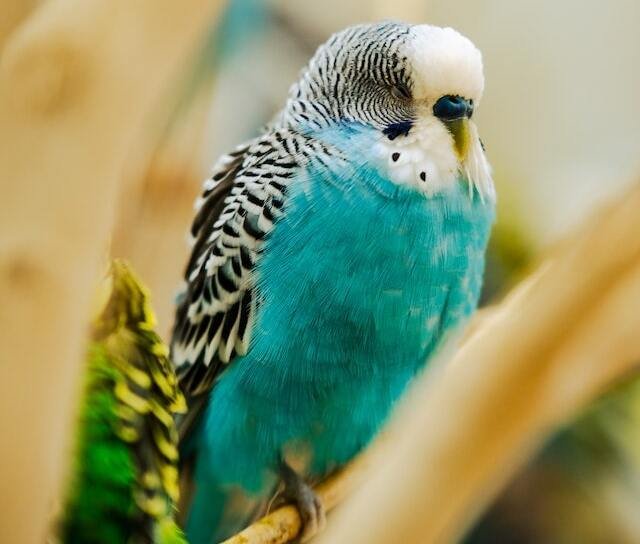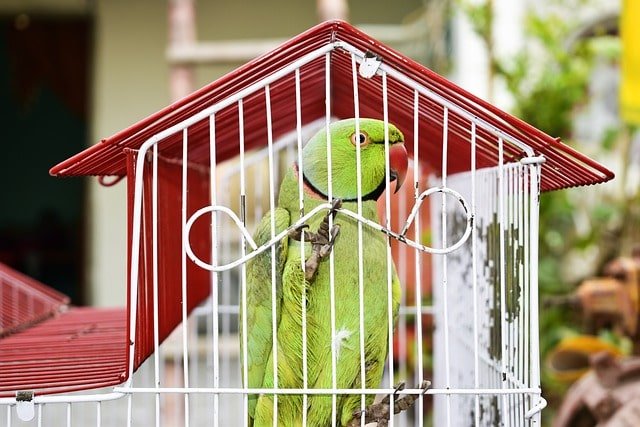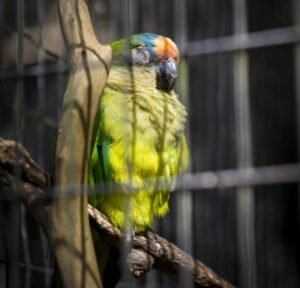It can be strange to notice your parrot peering at you while half asleep. But then again, no one likes to be disturbed.
Parrots do this most commonly during the daytime when they’re usually having a light nap. As odd as it may seem, it is nothing to worry about.
Parrots sleep while keeping their eyes open to stay alert for any potential threats. They take quick peeks into their surroundings to make sure it is safe before they can fall into a deep sleep. They are able to do this because of their ability to keep one-half of their brain awake during sleep.
Quick Navigation
Why Do Parrots Sleep With Their Eyes Open?
The reason why parrots sleep with their eyes open is to feel more secure. It is their way of staying alert to their surroundings while simultaneously allowing themselves to rest.
However, how their brain is able to do this is a bit more complex. I’ll do my best to explain how parrots are able to sleep with their eyes open.
Similar to mammals, birds have two types of sleep: non-rapid eye movement (NREM) sleep and rapid eye movement (REM) sleep. NREM refers to the stage of sleep when a parrot’s brain activity and physiological processes slow down.
However, different aspects of sleep can occur in specific areas of the brain. This means the intensity of sleep can be regulated, which enables the body to remain in a partly active state.
Because of this, parrots can experience deeper NREM sleep in one hemisphere of the brain. Frontiers in Neuroscience explains this phenomenon as unihemispheric NREM sleep.
During this type of sleep, only one hemisphere of the brain goes to sleep, while the other hemisphere stays awake or can be easily awakened. Parrots in unihemispheric NREM sleep usually sleep with one eye partly open. It gives them more situational awareness and helps them escape dangers.
The colloquial term used for this phenomenon is “peeking”. When birds sleep, they open their eyes from time to time to quickly take a peek at their surroundings for any threats.
In addition to differences in wakefulness between the two brain hemispheres during deep sleep, the intensity of sleep can also be regulated within each hemisphere based on how much is needed.
Slow brain waves, which are part of deep sleep, vary across different layers of the brain and start in certain areas before spreading out. These slow waves are strongest in specific layers of the brain. While most of the focus has been on deep sleep.
The intensity and distribution of NREM sleep are regulated locally within each hemisphere of the parrot’s brain. While in REM sleep, the muscles responsible for maintaining head and body posture might be relaxed.
Other local aspects of sleep involve a mix of features from NREM and REM sleep happening simultaneously in different parts of the parrot’s brain.
Should You Be Worried About Your Parrot Sleeping With Its Eyes Open?

In most cases, it is perfectly normal for parrots to sleep with their eyes open. It is their natural instinct to keep their eyes partly open, which indicates they are not in deep sleep.
If your parrot only sleeps for a short while and seems to be active and healthy when awake, it is probably nothing to worry about. Daytime sleep is supposed to be light. So you can let your parrot sleep with their eyes open without worrying about it too much.
However, if your parrot is closing one eye and doesn’t appear to be sleeping, it could possibly be a concerning matter. Parrots usually close their eyes out of discomfort or irritation. There could be a variety of causes for this problem. An eye infection or injury is often the most common cause.
When Do Parrots Sleep With Both Eyes Closed?
Parrots usually sleep with their eyes open during the day. During these naps, they are not in deep sleep and usually stay alert to predators. So even while they’re asleep, they are very sensitive to any noise or movement around them.
You can try observing a bird during its nap by sitting quietly nearby. You’ll notice the parrot’s eyelids start to close, but even the slightest movement or noise will make its eyes open up and awake immediately. At night though, parrots sleep differently.
Their sleep is deeper during this time as they’re tired. However, they still do get up a few times in the night to look around their cage. Their natural instincts do not allow them to sleep through the night.
How Do I Know If My Parrot Is Sleeping?
Parrots rarely go into deep sleep during the day, however, you can tell if your parrot is taking a short nap when it is roosting and has its eyes closed.
When a parrot is awake, it does not sit in one area of the cage and will often make various sounds and noises. But during sleep, it will hop onto its roost and be completely silent.
You may also see your parrot fluff up its feathers. It is like a blanket the parrot uses to feel more cozy and keep itself warm. You might also see them turn their heads and snuggle into their neck feathers for comfort.
Some parrots also like to stand on one leg while sleeping. And though it may seem like an uncomfortable position, it actually helps the parrot relax its foot while it rests.
Tips To Help Your Parrot Sleep Peacefully
Parrots need to sleep at least 10 hours daily. If they are not getting uninterrupted sleep consistently, they can become sleep deprived which can lead to behavioural problems.
So it is important you make sure they enough quality sleep every day. Here are some tips you should follow to provide better sleep to your parrots:

Darken Their Room
It’s easier for parrots to sleep when the environment is dark or dim. It helps to make them feel secure and sleep peacefully.
Light can make it difficult for parrots to fall asleep because they can see things happening in their surroundings which will keep them on their toes.
Remove Toys From Their Cage
This is an additional step you can take to prevent your parrot from getting scared in the dark by one of his toys. Parrots feel the safest when there’s no perceivable threat to them. Toys in the parrot’s cage can sometimes look scary to parrot when they wake up at night, as they are in the habit of.
Comfortable Room Temperature
Most people overlook the need for bird-appropriate temperatures in the room. Although they do adapt to the temperatures they are raised in, it can be hard for them to acclimate to extreme cold or heat.
And like us, they cannot put more clothes on to make up for the cold. Usually, a parrot would fluff up when it’s feeling cold to keep warm, but it would not be able to sleep as comfortably.
Keep The Noise Level Down
Parrots also need quiet in their room to soundly fall asleep. This is why it is recommended that you put your parrot to bed at a quiet hour to avoid noise from household members who would be active during that time.
Follow A Sleep Schedule
Plan your parrot’s day in a manner that they get enough time for quality sleep. Parrots like to follow a regimen and will be better off sleeping at a designated time than spending a few more hours staying awake. You shouldn’t wait for your parrot to feel drowsy before you put it to bed.







